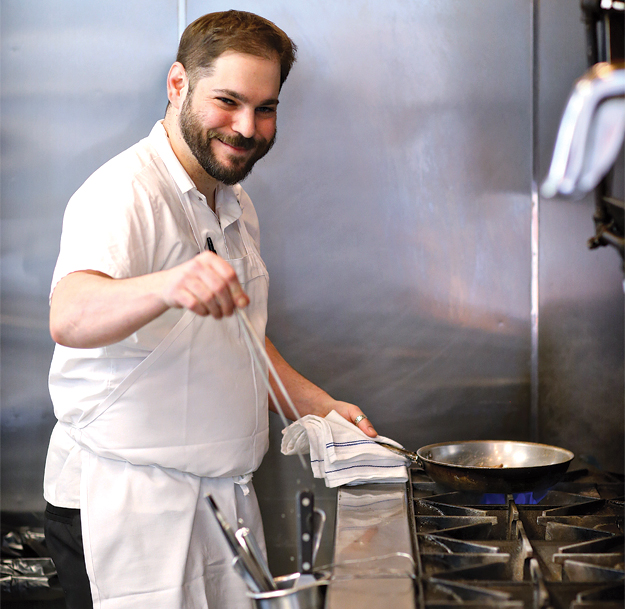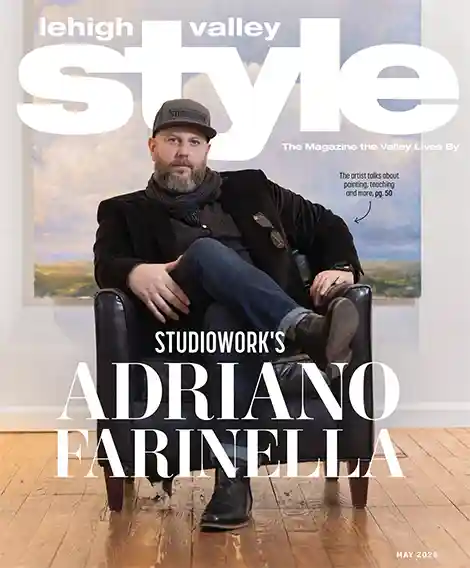
Chef Michael Joyce is excited. His spinach has arrived, delivered to the restaurant's back door by the farmer who picked it just hours ago.
“Go ahead and taste these,” he says. Four leaves of bright green spinach sit on a white plate. They are perfectly formed, tender. Savored slowly and without embellishment, every bite is delicious. “They're incredible.”
Joyce talks like that: Incredible. Exciting. Delicious. For him, every day in the kitchen at Molinari's is an adventure, a chance to open our eyes to how simple ingredients prepared with little fuss can produce outstanding results.
This morning's spinach will find its way onto this evening's menu as both a pizza topping and an intriguing new appetizer, the 60 Second Farm Egg. “We put this on the menu last night,” says Joyce. It's the ultimate poached egg, cooked for 60 seconds at a very low temperature and served with local mushrooms, ham and spinach.
Eggs aren't something you expect in an Italian restaurant, but the humble egg is Joyce's favorite thing to cook. You can even add one to any pizza. “They go well with so many things,” he says. Molinari's eggs come from a free range, organic flock in Coopersburg.
It's early spring when we talk and the warm sun is slanting through the tall windows on Third Street, a glimmer of good things to come: asparagus, peas and spring onions. Spring is an exciting time for Joyce. He can't wait to get his hands on those fresh ingredients. “You may find asparagus from Venezuela in January, but nothing compares to the local stuff that pops out of the ground in April.”
It's the same with tomatoes. They're best in July and August, but once the tomatoes are gone, they're off the menu. It can be hard to convey that an Italian restaurant doesn't have tomatoes year-round.
The changing seasons provide many such teachable moments at the restaurant. Since opening on Bethlehem's South Side four years ago, Molinari's has helped raise awareness of the joys of eating seasonably. It has also succeeded in educating the Lehigh Valley that food prepared the Italian way is really quite uncomplicated. No recipes or crazy cooking techniques, says Joyce, “just really good salt and some olive oil.”
Lesson One: Some of the menu is written in Italian. If you don't know what mushroom acqua pazza or Speck alto adige are, you might be missing something incredible. (When in doubt, ask your server.)
Joyce agrees that some diners fall out of their comfort zone. “They want the chicken Parm and they want the meatballs.” He loves those things, too; his grandmother's rigatoni and meatballs are out of this world. Ultimately, people try something new and they're happy. And they learn a little Italian.
It's part of what Joyce calls the “full experience of eating in Italy.” Dining the Italian way begins with meats and cheeses, salumi and formaggi. Get a little of both, maybe some olives and almonds and share them. It's the art of the table: slowing down, sampling and having a conversation.
There are always several choices of pasta on the menu, plus two fish and two meat dishes, but it is constantly evolving. Subtle changes to seasonings or techniques can transform a dish in a matter of a week or two. Joyce has to print new menus every day to keep up with it. Bad for trees, but good for diners who get to sample the work of a restless artist who finds inspiration everywhere.
A week earlier, Joyce and two of his kitchen crew ate at V Street, a vegan restaurant in Philadelphia. He says, “I had one of those incredible meals where I walk out and say ‘I know nothing about cooking.'” He finds food for thought in his travels, both here and abroad. He has a vast collection of cookbooks. He's connected with other chefs. One once recommended Joyce look at paintings in an art museum for inspiration in plating food.
There's a lot of creative energy on Bethlehem's Third Street lately and Molinari's is in the thick of it. The new Lehigh Valley Charter High School for the Arts opens across the street this fall. A Mexican restaurant and brewpub are going up in the empty lot next door. ArtsQuest is a few blocks east.
Joyce reaches out to his south side neighbors. On June 8 Molinari's will host a chef dinner as a fundraiser for the SouthSide Film Festival; six local chefs prepare one course each. His goal is to create a community of chefs and artists. He also wants to connect with more farmers and get closer to that ideal of being a sustainable restaurant.
Most of all, Joyce wants more people to experience what real food tastes like. The recipes that follow use ingredients that are in season right now and easily purchased in area markets.
Buy the best quality you can and don't rush the preparation. It will be incredible.
Editor's Note: Since our interview, Michael Joyce has accepted another position as a chef in the greater Philadelphia area.
Want to watch Chef Joyce in action?
Tune into The Chef's Kitchen on RCN-TV Channel 4 or, for Service Electric subscribers, Comcast Network's Channel 27 every Thursday at 5 p.m. during the month of June to see his tips and techniques to create this recipe.
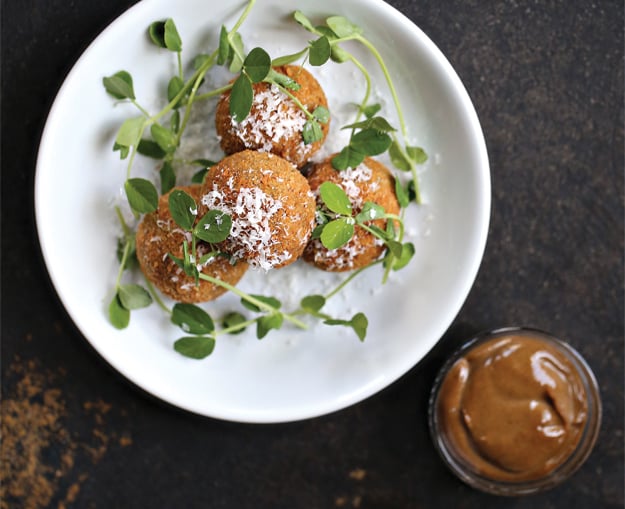
Roasted Mushroom & Sweet Pea Arancini
2 Tablespoons butter1 onion, diced0.5 ounce (1/2 cup) dried porcini mushrooms2 cups carnaroli rice (or aborio)1 bay leaf1 cup white wine8 cups mushroom stock1 cup mixed roasted mushrooms, chopped3/4 cup Parmesan Reggiano, grated1 egg1 1/2 cups fresh sweet peas, blanched (or frozen & defrosted)1/4 cup parsley, chopped8-ounce ball buffalo mozzarella, diced2 cups all-purpose flour6 cups fine breadcrumbs6 eggs
Place dried porcini mushrooms in a metal bowl and cover with boiling water. After 30 minutes, drain off hydrated mushrooms, reserving the porcini water and adding it to the mushroom stock. Rough chop mushrooms.
Heat up stock in a stainless steel pot. In a separate stainless steel pot with a wide bottom, melt butter. After the foam subsides, add onion and a pinch of sea salt. Sweat onions until soft and translucent. Add chopped porcinis and cook until onions are lightly browned. Add rice and toast for approximately 5 minutes until slightly aromatic.
Add wine and bay leaf. Cook until completely dry. Season rice with sea salt and cracked black pepper. In small additions, add warm stock. Constantly stir rice until completely evaporated.
Halfway through the cooking process, add roasted mushrooms. Continue to cook the risotto, using all the mushroom stock. Once all the stock has been added and risotto is completely dry, season with salt and pepper. Dump risotto onto a sheet pan covered with parchment paper and spread into a thin layer.
Once risotto is cooled, place in a large bowl. Add Parmesan, egg, peas and parsley. Mix well and chill. Roll risotto mix into 1 1/2-ounce balls, approximately the size of a golf ball. Push a piece of mozzarella into the center of each ball. Reseal. Prepare breading station. Whip eggs with 2 tablespoons of water. Place flour, egg and breadcrumbs in 3 separate, shallow containers.
First, a few risotto balls at a time, roll in flour. Shake off any excess flour and dip in eggs. Let any excess egg drip off and place in breadcrumbs. Make sure to completely coat balls with the breadcrumbs.
In a deep, stainless steel pot, heat vegetable or olive oil until a candy thermometer reads 350°F, carefully lower 3 or 4 at a time into the hot oil. Fry for 5-6 minutes until golden brown. Remove from the oil with a slotted spoon and place on a plate lined with paper towels. Immediately season with sea salt and fresh pepper.
Serve with Black Garlic Pesto Aioli.
Black Garlic Aioli
1 egg2 egg yolks3 heads black garlic, cloves only1 teaspoon mustard powder2 Tablespoons white balsamic vinegar1/2 cup water2 teaspoons salt1 teaspoon black pepper3 cups canola/vegetable oil2 cups extra virgin olive oil1-2 Tablespoons premium quality balsamic vinegar
Place all ingredients, except the oils, in the bowl of a food processor. Turn on and pulse until you have a smooth, black puree. At this point, begin to slowly drizzle in both oils until you achieve a creamy, mayo-like sauce. Season with salt, pepper and the aged Balsamic vinegar.
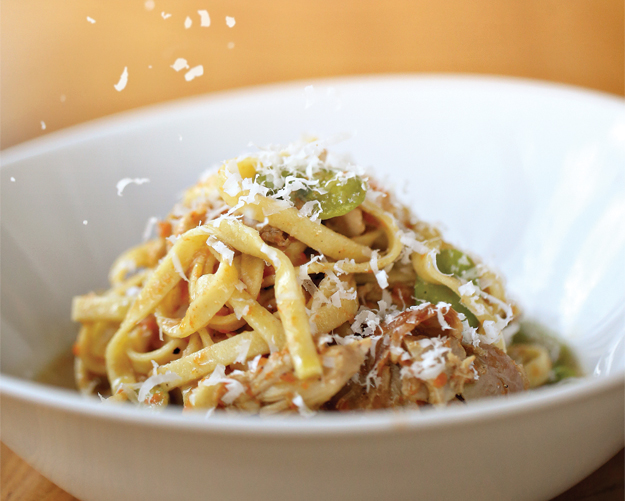
Macceroni alla Chitarra with Braised Rabbit, Fava Beans, Mint and Pecorino Romano
1 rabbit, whole, 3 lbs.1 onion, chopped1 carrot, chopped2-3 ribs of celery, chopped8 cloves garlic1 cup white wine, preferably Trebbiano d'Abruzzo6 cups brown chicken stock1 bay leaf1 fresh herb bundle with oregano and thyme, tied with butcher twine2 Tablespoons butter1 Tablespoon mint, chopped1/4 cup Pecorino Romano, grated1/2 cup fava beans, shelled & blanched1 lb. high quality dried pasta; fettuccine works well
Preheat oven to 400°F. Cut the rabbit into quarters and season all over with salt and fresh pepper. Dress lightly with olive oil and place on a baking sheet. Place into the oven and roast until the rabbit is a golden-brown, about 20 minutes. While rabbit is roasting, preheat a large sauté pan big enough to
accommodate all the chopped vegetables.
Add a thin layer of olive oil and all the vegetables. Continue to cook the vegetables until slightly caramelized and softened. Add white wine and reduce until the pan is almost dry. Add chicken stock and bring to a boil. At this point, dump the contents of the sauté pan into a roasting pan big enough to accommodate all the vegetables, stock and rabbit. When the rabbit is finished roasting, carefully remove pan from the oven. Turn the oven down to 350°F. Using tongs, place the rabbit into the prepared stock. Drain off any oil left on the pan and deglaze the pan with a little bit of wine to remove the leftover caramelized “fond.” Add to the stock along with your herbs. Cover the roasting pan with aluminum foil and place in the oven. Braise rabbit for approximately one and a half hours or until the meat is falling off the bone.
Remove the rabbit from the stock. Discard herb bundle and bay leaf. While rabbit is cooling, pass the vegetables and stock through a food mill. When rabbit is cool, pick the meat from the bones, being careful to remove all the small bones.
Place a pot of water on the stove. Bring to a boil and season generously with salt. Cook pasta according to the instructions on the package. Place rabbit sauce, rabbit and blanched fava beans in a wide sauté pan and bring to a boil. Turn heat down to a simmer and reduce down until slightly thickened. Drain off pasta when it is cooked, reserving 1 cup of the pasta water for the sauce. Add pasta to the sauce along with the butter, mint and cheese. Turn up the heat on the pan and cook sauce until it clings to the pasta, add reserved pasta water if it becomes too dry. Season with salt and pepper and then remove pasta to a large bowl.
Upon serving: Drizzle with a high quality olive oil and top with freshly grated Pecorino.
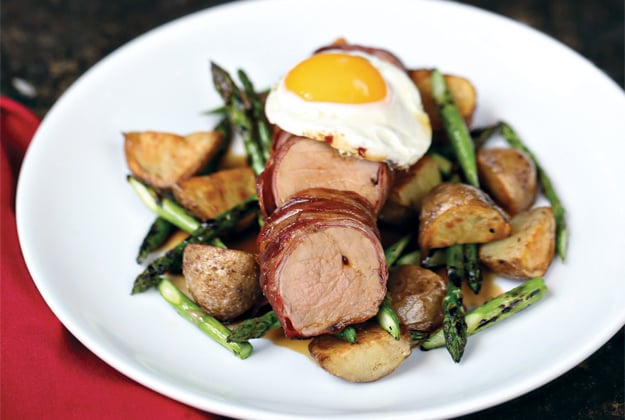
Speck-Wrapped Pork Tenderloin with Roasted New Potatoes, Grilled Asparagus and an Olive-Oil Fried Farm Egg
2 pork tenderloins, trimmed and cleaned of any silver skin12 slice Speck Alto Adige, or pancetta/bacon1 lb. small new potatoes, scrubbed and quartered3 garlic cloves1 bay leaf1 teaspoon black peppercorns6 sprigs fresh thyme1 Tablespoon butter1 bunch asparagus, woody bottoms removed2 local farm eggs
Preheat your oven to 350°F. Lay six overlapping slices of Speck side-by-side. Place one tenderloin on the Speck and carefully wrap the pork, making sure there are no gaps and that it remains tight. Continue with the second tenderloin. Wrap both tenderloins tightly in plastic wrap. Place in the fridge for at least one hour. This will help the Speck adhere to the pork better while it roasts.
Place the quartered potatoes in a large pot along with the thyme, garlic, bay and peppercorns. Cover by about an inch of cold water. Season liberally with salt. Place pot on a burner and bring to a boil. Reduce heat to a simmer and cook until easily pierced with a knife. Carefully drain and place in a pan to cool. Cut each asparagus spear on a diagonal into 2-3 pieces. Season with olive oil, salt and pepper.
Preheat a cast-iron pan until almost smoking. Add a thin layer of canola oil and place the tenderloins in the pan, laying them first on the overlapping seam. This will help to ensure that they do not unravel. Cook on all four sides until the Speck is golden brown. Remove pork to an ovenproof pan and place in the oven. Cook for approximately 8-10 minutes. Once pork is fully cooked, remove from the oven and rest in a warm place for 15 minutes before slicing.
While pork is roasting, prepare the vegetables. Preheat a grill pan or an outdoor grill. Melt butter in a large ovenproof sauté pan and carefully place potatoes in the pan, cut side down. Place in the oven and roast until potatoes are crispy and golden brown, about 6-8 minutes. Remove from the oven, season with salt and pepper and place on a plate lined with paper towels. Place the asparagus on the grill and cook until slightly charred, but still crispy. Remove to the plate holding the potatoes.
Preheat two nonstick pans with a thin layer of good olive oil. Crack an egg into each pan. Season with salt and pepper. Slowly cook until egg white is fully cooked. Slice pork on a slight bias. Scatter two plates with both the asparagus and new potatoes. Top with the sliced pork. Place an egg onto each tenderloin.
Upon serving: Drizzle with premium olive oil and grind some fresh pepper on the egg.


